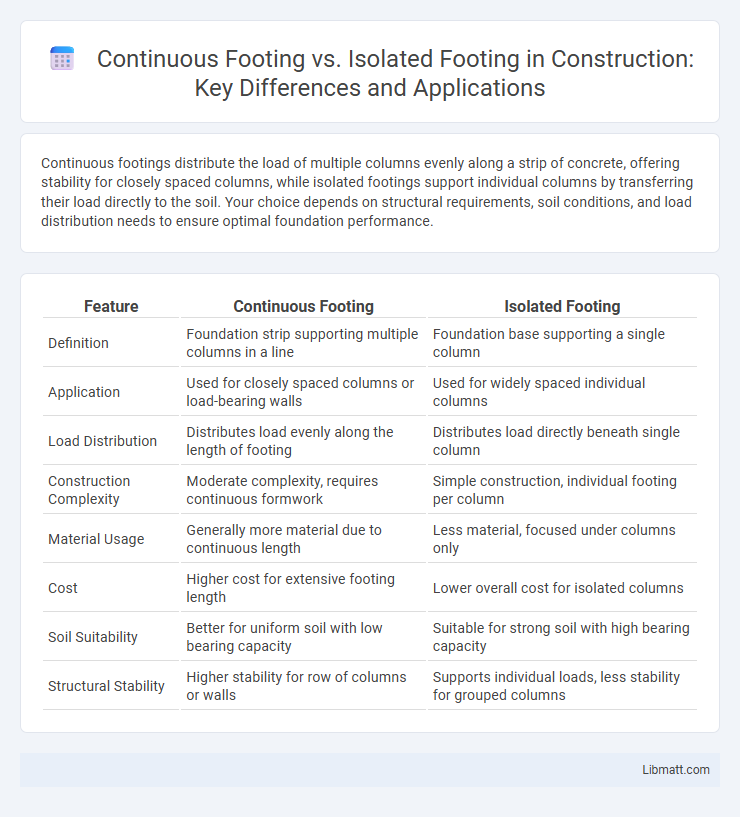Continuous footings distribute the load of multiple columns evenly along a strip of concrete, offering stability for closely spaced columns, while isolated footings support individual columns by transferring their load directly to the soil. Your choice depends on structural requirements, soil conditions, and load distribution needs to ensure optimal foundation performance.
Table of Comparison
| Feature | Continuous Footing | Isolated Footing |
|---|---|---|
| Definition | Foundation strip supporting multiple columns in a line | Foundation base supporting a single column |
| Application | Used for closely spaced columns or load-bearing walls | Used for widely spaced individual columns |
| Load Distribution | Distributes load evenly along the length of footing | Distributes load directly beneath single column |
| Construction Complexity | Moderate complexity, requires continuous formwork | Simple construction, individual footing per column |
| Material Usage | Generally more material due to continuous length | Less material, focused under columns only |
| Cost | Higher cost for extensive footing length | Lower overall cost for isolated columns |
| Soil Suitability | Better for uniform soil with low bearing capacity | Suitable for strong soil with high bearing capacity |
| Structural Stability | Higher stability for row of columns or walls | Supports individual loads, less stability for grouped columns |
Introduction to Foundations
Continuous footing and isolated footing are two fundamental types of shallow foundations used to support structures. Continuous footings distribute load uniformly along a wall or series of columns, ideal for supporting load-bearing walls, while isolated footings support individual columns, concentrating loads to specific points. Choice between these footings depends on soil bearing capacity, load type, and structural design requirements.
What is Continuous Footing?
Continuous footing is a type of shallow foundation used to support a row of load-bearing walls or closely spaced columns, distributing structural loads evenly across the soil. It typically consists of a long strip of concrete that runs continuously beneath the entire length of the structure, providing enhanced stability and load distribution. This footing is often preferred for buildings with multiple columns in a line, reducing differential settlement and improving structural integrity.
What is Isolated Footing?
Isolated footing supports a single column, distributing the load directly to the soil beneath, making it ideal for structures with widely spaced columns. It typically consists of a square or rectangular concrete pad that helps prevent settlement by spreading the load evenly. Your choice between isolated footing and continuous footing depends on load distribution, soil conditions, and structural design requirements.
Key Differences Between Continuous and Isolated Footings
Continuous footing supports multiple columns in a row, distributing loads evenly along the length, making it ideal for structures with closely spaced columns. Isolated footing, designed for individual columns, transfers load directly to the soil beneath, suitable for widely spaced columns where load concentration is critical. Your choice between the two depends on column spacing, load distribution requirements, and soil bearing capacity.
Load Distribution in Continuous vs Isolated Footings
Continuous footings distribute structural loads evenly across a long strip, providing enhanced stability for walls or closely spaced columns by spreading forces over a larger soil area. Isolated footings concentrate loads from individual columns, transferring stress to the soil beneath discrete pads, which can lead to higher pressure points requiring stronger soil bearing capacity. The load distribution in continuous footings reduces differential settlement compared to isolated footings, making them ideal for linear load-bearing elements.
Advantages of Continuous Footing
Continuous footing offers superior load distribution along the entire length of a wall or row of columns, reducing the risk of differential settlement. This type of footing is especially advantageous for supporting multiple columns with varying loads, providing enhanced structural stability. Your construction project benefits from cost savings and material efficiency due to its simpler formwork and reduced excavation compared to isolated footings.
Advantages of Isolated Footing
Isolated footing provides effective load distribution for individual columns, making it ideal for structures with spaced supports and moderate loads. It offers simplicity in design and construction, leading to cost efficiency and faster installation compared to continuous footing. Suitable for sites with varying soil conditions, isolated footing reduces the risk of differential settlement by supporting columns independently.
Applications and Suitability
Continuous footings are ideal for supporting a row of closely spaced columns or load-bearing walls, commonly used in structures like warehouses, residential buildings, and retaining walls where loads are moderate and evenly distributed. Isolated footings are best suited for individual columns with heavy loads, typically found in commercial buildings and multi-story constructions where point loads need focused support. Your choice depends on the load distribution, soil bearing capacity, and structural layout, ensuring the foundation meets stability and efficiency requirements.
Factors Influencing Footing Selection
Soil bearing capacity, structural load type, and spacing of columns critically influence the selection between continuous and isolated footings; continuous footings are preferred for closely spaced columns or walls to distribute loads evenly, whereas isolated footings suit widely spaced columns with moderate loads. Economic considerations also play a vital role, as continuous footings often require less excavation and concrete for multiple columns, reducing overall cost in certain soil conditions. Site constraints, such as soil type variability and groundwater levels, further dictate the appropriate footing type to ensure stability and minimize settlement risks.
Conclusion: Choosing the Right Footing Type
Selecting the appropriate footing type depends on soil conditions, load distribution, and structural design requirements. Continuous footings provide uniform support for closely spaced columns, ideal for walls or rows of columns, while isolated footings are suitable for individual columns with concentrated loads on stable soil. Proper analysis of site conditions and structural demands ensures optimal foundation performance and cost efficiency.
Continuous footing vs Isolated footing Infographic

 libmatt.com
libmatt.com